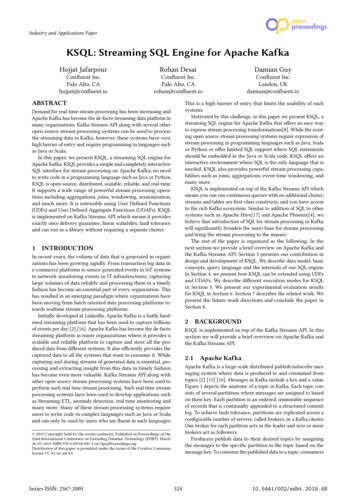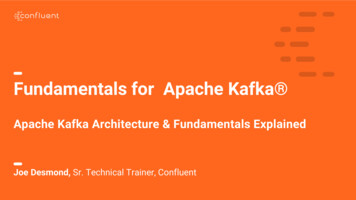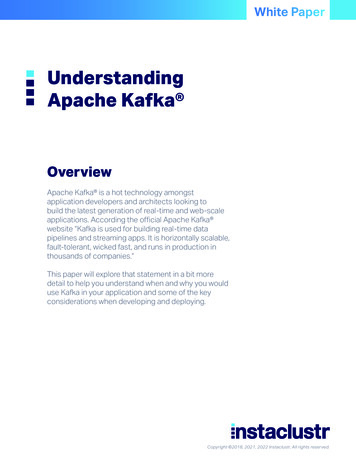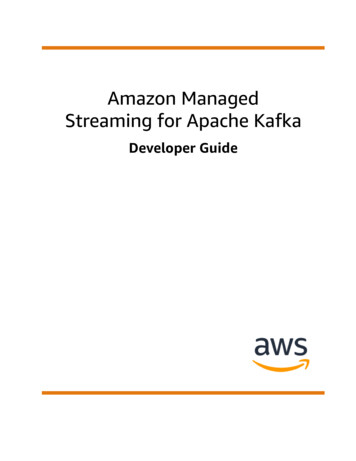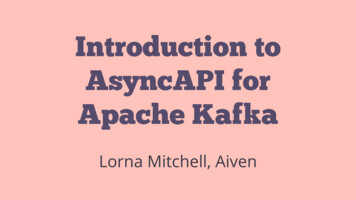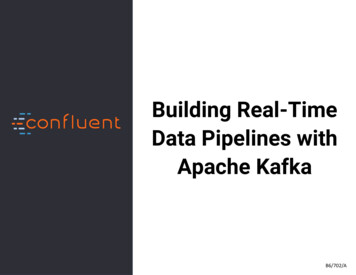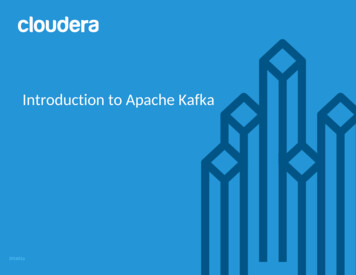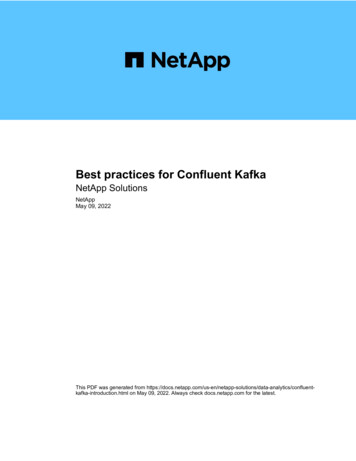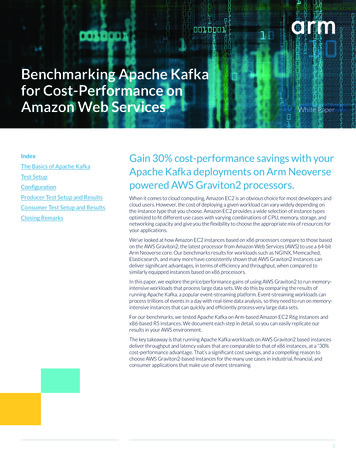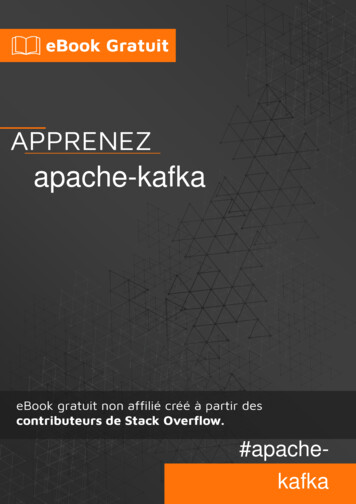
Transcription
Apache KafkaAbout the TutorialApache Kafka was originated at LinkedIn and later became an open sourced Apache project in2011, then First-class Apache project in 2012. Kafka is written in Scala and Java. Apache Kafkais publish-subscribe based fault tolerant messaging system. It is fast, scalable and distributedby design.This tutorial will explore the principles of Kafka, installation, operations and then it will walk youthrough with the deployment of Kafka cluster. Finally, we will conclude with real-timeapplications and integration with Big Data Technologies.AudienceThis tutorial has been prepared for professionals aspiring to make a career in Big Data Analyticsusing Apache Kafka messaging system. It will give you enough understanding on how to useKafka clusters.PrerequisitesBefore proceeding with this tutorial, you must have a good understanding of Java, Scala,Distributed messaging system, and Linux environment.Copyright and Disclaimer Copyright 2016 by Tutorials Point (I) Pvt. Ltd.All the content and graphics published in this e-book are the property of Tutorials Point (I) Pvt.Ltd. The user of this e-book is prohibited to reuse, retain, copy, distribute or republish anycontents or a part of contents of this e-book in any manner without written consent of thepublisher.We strive to update the contents of our website and tutorials as timely and as precisely aspossible, however, the contents may contain inaccuracies or errors. Tutorials Point (I) Pvt. Ltd.provides no guarantee regarding the accuracy, timeliness or completeness of our website or itscontents including this tutorial. If you discover any errors on our website or in this tutorial,please notify us at contact@tutorialspoint.comi
Apache KafkaTable of ContentsAbout the Tutorial. iAudience . iPrerequisites . iCopyright and Disclaimer . iTable of Contents . ii1.KAFKA – INTRODUCTION . 1What is a Messaging System? . 1What is Kafka? . 22.KAFKA – FUNDAMENTALS. 43.KAFKA – CLUSTER ARCHITECTURE . 74.KAFKA – WORKFLOW. 9Workflow of Pub-Sub Messaging . 9Workflow of Queue Messaging / Consumer Group . 10Role of ZooKeeper. 115.KAFKA – INSTALLATION STEPS . 12Step 1: Verifying Java Installation . 12Step 2: ZooKeeper Framework Installation . 13Step 3: Apache Kafka Installation . 15Step 4: Stop the Server. 166.KAFKA – BASIC OPERATIONS. 17Single Node-Single Broker Configuration . 17List of Topics . 18Single Node-Multiple Brokers Configuration . 20ii
Apache KafkaCreating a Topic . 21Basic Topic Operations . 22Deleting a Topic . 237.KAFKA – SIMPLE PRODUCER EXAMPLE . 24KafkaProducer API . 24Producer API . 25Configuration Settings. 25ProducerRecord API . 26SimpleProducer application . 27Simple Consumer Example . 29ConsumerRecord API . 30ConsumerRecords API . 31Configuration Settings. 31SimpleConsumer Application . 328.KAFKA – CONSUMER GROUP EXAMPLE . 349.KAFKA – INTEGRATION WITH STORM . 37About Storm . 37Integration with Storm. 37Bolt Creation . 39Submitting to Topology . 42Execution . 4410. KAFKA – INTEGRATION WITH SPARK. 45About Spark . 45Integration with Spark . 4511. KAFKA – REAL-TIME APPLICATION (TWITTER) . 50iii
Apache KafkaTwitter Streaming API . 5012. KAFKA – TOOLS . 55System Tools . 55Replication Tool . 5513. KAFKA – APPLICATIONS . 56iv
1. Kafka – IntroductionApache KafkaIn Big Data, an enormous volume of data is used. Regarding data, we have two mainchallenges. The first challenge is how to collect large volume of data and the second challengeis to analyze the collected data. To overcome those challenges, you must need a messagingsystem.Kafka is designed for distributed high throughput systems. Kafka tends to work very well asa replacement for a more traditional message broker. In comparison to other messagingsystems, Kafka has better throughput, built-in partitioning, replication and inherent faulttolerance, which makes it a good fit for large-scale message processing applications.What is a Messaging System?A Messaging System is responsible for transferring data from one application to another, sothe applications can focus on data, but not worry about how to share it. Distributed messagingis based on the concept of reliable message queuing. Messages are queued asynchronouslybetween client applications and messaging system. Two types of messaging patterns areavailable – one is point to point and the other is publish-subscribe (pub-sub) messagingsystem. Most of the messaging patterns follow pub-sub.Point to Point Messaging SystemIn a point-to-point system, messages are persisted in a queue. One or more consumers canconsume the messages in the queue, but a particular message can be consumed by amaximum of one consumer only. Once a consumer reads a message in the queue, itdisappears from that queue. The typical example of this system is an Order ProcessingSystem, where each order will be processed by one Order Processor, but Multiple OrderProcessors can work as well at the same time. The following diagram depicts the structure.5
Apache KafkaPublish-Subscribe Messaging SystemIn the publish-subscribe system, messages are persisted in a topic. Unlike point-to-pointsystem, consumers can subscribe to one or more topic and consume all the messages in thattopic. In the Publish-Subscribe system, message producers are called publishers and messageconsumers are called subscribers. A real-life example is Dish TV, which publishes differentchannels like sports, movies, music, etc., and anyone can subscribe to their own set ofchannels and get them whenever their subscribed channels are available.What is Kafka?Apache Kafka is a distributed publish-subscribe messaging system and a robust queue thatcan handle a high volume of data and enables you to pass messages from one end-point toanother. Kafka is suitable for both offline and online message consumption. Kafka messagesare persisted on the disk and replicated within the cluster to prevent data loss. Kafka is builton top of the ZooKeeper synchronization service. It integrates very well with Apache Stormand Spark for real-time streaming data analysis.BenefitsFollowing are a few benefits of Kafka: Reliability - Kafka is distributed, partitioned, replicated and fault tolerance. Scalability - Kafka messaging system scales easily without down time. Durability - Kafka uses “Distributed commit log” which means messages persists ondisk as fast as possible, hence it is durable. Performance - Kafka has high throughput for both publishing and subscribingmessages. It maintains stable performance even many TB of messages are stored.6
Apache KafkaKafka is very fast and guarantees zero downtime and zero data loss.Use CasesKafka can be used in many Use Cases. Some of them are listed below: Metrics - Kafka is often used for operational monitoring data. This involvesaggregating statistics from distributed applications to produce centralized feeds ofoperational data. Log Aggregation Solution - Kafka can be used across an organization to collect logsfrom multiple services and make them available in a standard format to multipleconsumers. Stream Processing - Popular frameworks such as Storm and Spark Streaming readdata from a topic, processes it, and write processed data to a new topic where itbecomes available for users and applications. Kafka’s strong durability is also veryuseful in the context of stream processing.Need for KafkaKafka is a unified platform for handling all the real-time data feeds. Kafka supports low latencymessage delivery and gives guarantee for fault tolerance in the presence of machine failures.It has the ability to handle a large number of diverse consumers. Kafka is very fast, performs2 million writes/sec. Kafka persists all data to the disk, which essentially means that all thewrites go to the page cache of the OS (RAM). This makes it very efficient to transfer datafrom page cache to a network socket.7
2. Kafka – FundamentalsApache KafkaBefore moving deep into the Kafka, you must aware of the main terminologies such as topics,brokers, producers and consumers. The following diagram illustrates the main terminologiesand the table describes the diagram components in detail.In the above diagram, a topic is configured into three partitions. Partition 1 has two offsetfactors 0 and 1. Partition 2 has four offset factors 0, 1, 2, and 3. Partition 3 has one offsetfactor 0. The id of the replica is same as the id of the server that hosts it.Assume, if the replication factor of the topic is set to 3, then Kafka will create 3 identicalreplicas of each partition and place them in the cluster to make available for all its operations.To balance a load in cluster, each broker stores one or more of those partitions. Multipleproducers and consumers can publish and retrieve messages at the same time.8
Apache KafkaComponentsDescriptionTopicsA stream of messages belonging to a particular category is called atopic. Data is stored in topics.PartitionTopics are split into partitions. For each topic, Kafka keeps aminimum of one partition. Each such partition contains messages inan immutable ordered sequence. A partition is implemented as a setof segment files of equal sizes.Topics may have many partitions, so it can handle an arbitraryamount of data.Partition offsetReplicas of partitionEach partitioned message has a unique sequence id called as“offset”.Replicas are nothing but “backups” of a partition. Replicas are neverread or write data. They are used to prevent data loss.i) Brokers are simple system responsible for maintaining thepublished data. Each broker may have zero or more partitions pertopic. Assume, if there are N partitions in a topic and N number ofbrokers, each broker will have one partition.Brokersii) Assume if there are N partitions in a topic and more than N brokers(n m), the first N broker will have one partition and the next Mbroker will not have any partition for that particular topic.iii) Assume if there are N partitions in a topic and less than N brokers(n-m), each broker will have one or more partition sharing amongthem. This scenario is not recommended due to unequal loaddistribution among the broker.Kafka ClusterKafka’s having more than one broker are called as Kafka cluster. AKafka cluster can be expanded without downtime. These clusters areused to manage the persistence and replication of message data.9
Apache KafkaProducersProducers are the publisher of messages to one or more Kafka topics.Producers send data to Kafka brokers. Every time a producerpublishes a message to a broker, the broker simply appends themessage to the last segment file. Actually, the message will beappended to a partition. Producer can also send messages to apartition of their choice.ConsumersConsumers read data from brokers. Consumers subscribes to one ormore topics and consume published messages by pulling data fromthe brokers.Leader"Leader" is the node responsible for all reads and writes for the givenpartition. Every partition has one server acting as a leader.FollowerNode which follows leader instructions are called as follower. If theleader fails, one of the follower will automatically become the newleader. A follower acts as normal consumer, pulls messages andupdates its own data store.10
3. Kafka – Cluster ArchitectureApache KafkaTake a look at the following illustration. It shows the cluster diagram of Kafka.11
Apache KafkaEnd of ebook previewIf you liked what you saw Buy it from our store @ https://store.tutorialspoint.com12
Apache Kafka 5 In Big Data, an enormous volume of data is used. Regarding data, we have two main challenges. The first challenge is how to collect large volume of data and the second challenge is to analyze the collected data. To overcome those challenges, you must need a messaging system. Kafka
